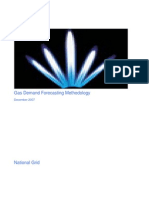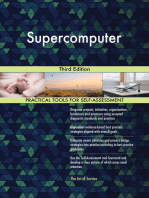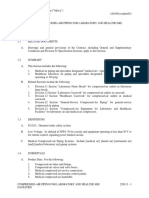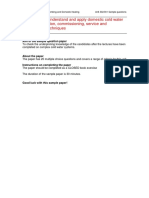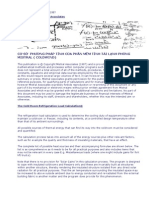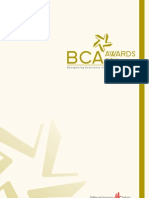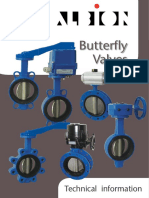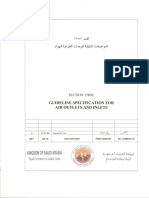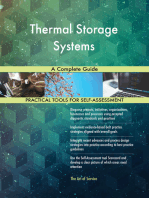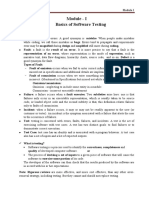SECTION 22 61 19 Compressed-Air Equipment For Laboratory and Healthcare Facilities
SECTION 22 61 19 Compressed-Air Equipment For Laboratory and Healthcare Facilities
Uploaded by
Karuna KaranCopyright:
Available Formats
SECTION 22 61 19 Compressed-Air Equipment For Laboratory and Healthcare Facilities
SECTION 22 61 19 Compressed-Air Equipment For Laboratory and Healthcare Facilities
Uploaded by
Karuna KaranOriginal Description:
Original Title
Copyright
Available Formats
Share this document
Did you find this document useful?
Is this content inappropriate?
Copyright:
Available Formats
SECTION 22 61 19 Compressed-Air Equipment For Laboratory and Healthcare Facilities
SECTION 22 61 19 Compressed-Air Equipment For Laboratory and Healthcare Facilities
Uploaded by
Karuna KaranCopyright:
Available Formats
Ambulatory Surgical Institute of Dallas 26 October 2012
Addison, Texas AGA Project No. 2012-063
TLC Project No. 212157
SECTION 22 61 19
COMPRESSED-AIR EQUIPMENT FOR LABORATORY AND HEALTHCARE FACILITIES
PART 1 - GENERAL
1.1 RELATED DOCUMENTS
A. Drawings and general provisions of the Contract, including General and Supplementary
Conditions and Division 01 Specification Sections, apply to this Section.
1.2 SUMMARY
A. Section Includes:
1. Packaged, rotary-screw air compressors.
2. Desiccant compressed-air dryers.
3. Computer interface cabinet.
1.3 DEFINITIONS
A. Actual Air: Air delivered at air-compressor outlet. Flow rate is compressed air delivered and
measured in acfm.
B. Laboratory Air Equipment: Compressed-air equipment and accessories for nonmedical
laboratory facilities.
C. Low Voltage: As defined in NFPA 70 for circuits and equipment operating at less than 50 V or
for remote-control, signaling power-limited circuits.
D. Medical Air Equipment: Compressed-air equipment and accessories for healthcare facilities.
E. Standard Air: Free air at 68 deg F and 1 atmosphere before compression or expansion and
measured in scfm.
1.4 PERFORMANCE REQUIREMENTS
A. Delegated Design: Design compressed-air equipment mounting, including comprehensive
engineering analysis by a qualified professional engineer, using performance requirements and
design criteria indicated.
1.5 SUBMITTALS
A. Product Data: For each type of product indicated. Include rated capacities, operating
characteristics, electrical characteristics, and furnished specialties and accessories.
1. Wiring Diagrams: For power, signal, and control wiring.
COMPRESSED-AIR EQUIPMENT FOR LABORATORY AND HEALTHCARE FACILITIES
22 61 19 - 1
Ambulatory Surgical Institute of Dallas 26 October 2012
Addison, Texas AGA Project No. 2012-063
TLC Project No. 212157
B. Delegated-Design Submittal: For compressed-air equipment mounting indicated to comply with
performance requirements and design criteria, including analysis data signed and sealed by the
qualified professional engineer responsible for their preparation.
1. Detail fabrication and assembly of supports.
2. Design Calculations: Calculate requirements for selecting vibration isolators and for
designing vibration isolation bases.
C. Qualification Data: For qualified Installer and testing agency.
D. Field quality-control reports.
E. Operation and Maintenance Data: For compressed-air equipment to include in operation and
maintenance manuals.
1.6 QUALITY ASSURANCE
A. Installer Qualifications:
1. Laboratory Air System Equipment for Non-medical Laboratory Facilities: An employer of
workers trained and approved by manufacturer.
2. Medical Air System Equipment for Healthcare Facilities: Qualify installers according to
ASSE 6010.
B. Testing Agency Qualifications: An independent testing agency, with the experience and
capability to conduct the compressed-air equipment testing indicated, that is a member of the
Medical Gas Professional Healthcare Organization or is an NRTL and that is acceptable to
authorities having jurisdiction.
1. Qualify testing personnel according to ASSE 6020 for inspectors and ASSE 6030 for
verifiers.
C. Electrical Components, Devices, and Accessories: Listed and labeled as defined in NFPA 70,
by a qualified testing agency, and marked for intended location and application.
D. ASME Compliance: Fabricate and label receivers to comply with ASME Boiler and Pressure
Vessel Code.
E. Comply with NFPA 99, "Health Care Facilities," for compressed-air equipment and accessories
for medical air systems.
F. Comply with UL 544, "Medical and Dental Equipment," for medical compressed-air equipment.
1.7 COORDINATION
A. Coordinate sizes and locations of concrete bases with equipment provided.
PART 2 - PRODUCTS
COMPRESSED-AIR EQUIPMENT FOR LABORATORY AND HEALTHCARE FACILITIES
22 61 19 - 2
Ambulatory Surgical Institute of Dallas 26 October 2012
Addison, Texas AGA Project No. 2012-063
TLC Project No. 212157
2.1 GENERAL REQUIREMENTS FOR PACKAGED AIR COMPRESSORS
A. Description: Factory-assembled, -wired, -piped, and -tested; electric-motor-driven; air-cooled;
continuous-duty air compressors and receivers that deliver air of quality equal to intake air.
B. Control Panels: Automatic control station with load control and protection functions. Comply
with NEMA ICS 2 and UL 508.
1. Enclosure: NEMA ICS 6, Type 12 control panel unless otherwise indicated.
2. Motor Controllers: Full-voltage, combination-magnetic type with undervoltage release
feature and motor-circuit-protector-type disconnecting means and short-circuit protective
device.
3. Control Voltage: 120-V ac or less, using integral control power transformer.
4. Motor Overload Protection: Overload relay in each phase.
5. Starting Devices: Hand-off-automatic selector switch in cover of control panel, plus pilot
device for automatic control.
6. Automatic control switches to sequence lead-lag air compressors for multiplex air
compressors.
7. Instrumentation: Include discharge-air and receiver pressure gages, air-filter
maintenance indicator, hour meter, air-compressor discharge-air and coolant temperature
gages, and control transformer.
8. Alarm Signal Device: For connection to alarm system to indicate when backup air
compressor is operating.
C. Receivers: Steel tank constructed according to ASME Boiler and Pressure Vessel Code:
Section VIII, Division 1.
1. Pressure Rating: At least as high as highest discharge pressure of connected air
compressors and bearing appropriate code symbols.
2. Interior Finish: Corrosion-resistant coating.
3. Accessories: Include safety valve, pressure gage, automatic drain, and pressure
regulator.
2.2 ROTARY-SCREW AIR COMPRESSORS
A. Manufacturers: Subject to compliance with requirements,
1. BeacoMedaes, Ohio Medical or Amico
B. Description: Packaged unit.
C. Air Compressor(s): Single-stage, oil-free, rotary, helical-screw type with nonlubricated helical
screws and lubricated gearbox, and of construction that prohibits oil from entering compression
chamber.
1. Cooling/Lubrication System: Unit-mounted, air-cooled exchanger package prepiped to
unit; with air-pressure circulation system with coolant stop valve, full-flow coolant filter,
and thermal-bypass valve.
2. Air Filter: Dry type, with maintenance indicator and cleanable replaceable filter element.
3. Air/Coolant Receiver and Separation System: 150-psig- rated steel tank with ASME
safety valve, coolant-level gage, multistage air-coolant separator element, minimum
pressure valve, blowdown valve, discharge check valve, coolant stop valve, full-flow
coolant filter, and thermal-bypass valve.
COMPRESSED-AIR EQUIPMENT FOR LABORATORY AND HEALTHCARE FACILITIES
22 61 19 - 3
Ambulatory Surgical Institute of Dallas 26 October 2012
Addison, Texas AGA Project No. 2012-063
TLC Project No. 212157
4. Capacity Control: Capacity modulation between 0 and 100 percent air delivery, with
operating pressures between 50 and 100 psig . Include necessary control to hold
constant pressure. When air demand is zero, unload compressor by using pressure
switch and blowdown valve.
5. Mounting: Freestanding.
D. Sound-attenuation enclosure.
E. Capacities and Characteristics: See Medical Air Compressor Schedule on the drawings.
2.3 DESICCANT COMPRESSED-AIR DRYERS
A. Manufacturers: Subject to compliance with requirements, provide products by one of the
following:
1. BeaconMedaes, Ohio Medical or Amico.
B. Description: Twin-tower unit with purge system, mufflers, and capability to deliver plus 10
deg F 100-psig air at dew point. Include dew point controlled purge, step-down transformers,
disconnect switches, inlet and outlet pressure gages, thermometers, automatic controls, and
filters.
C. Capacities and Characteristics: See Medical Air Compressor Schedule on drawings.
2.4 MOTORS
A. Comply with NEMA designation, temperature rating, service factor, enclosure type, and
efficiency requirements for motors specified in Division 22 Section "Common Motor
Requirements for Plumbing Equipment."
1. Motor Sizes: Minimum size as indicated. If not indicated, large enough so driven load
will not require motor to operate in service factor range above 1.0.
2. Controllers, Electrical Devices, and Wiring: Comply with requirements for electrical
devices and connections specified in Division 26 Sections.
2.5 COMPUTER INTERFACE CABINET
A. Description:
1. Wall mounting.
2. Welded steel with white-enamel finish.
3. Gasketed door.
4. Grounding device.
5. Factory-installed signal circuit boards.
6. Power transformer.
7. Circuit breaker.
8. Wiring terminal board.
9. Internal wiring capable of interfacing 20 alarm signals.
PART 3 - EXECUTION
COMPRESSED-AIR EQUIPMENT FOR LABORATORY AND HEALTHCARE FACILITIES
22 61 19 - 4
Ambulatory Surgical Institute of Dallas 26 October 2012
Addison, Texas AGA Project No. 2012-063
TLC Project No. 212157
3.1 PREPARATION
A. Clean compressed-air equipment, accessories, and components that have not been cleaned for
oxygen service and sealed or that are furnished unsuitable for medical air applications,
according to CGA G-4.1, "Cleaning Equipment for Oxygen Service."
3.2 COMPRESSED-AIR EQUIPMENT INSTALLATION
A. General Requirements for Compressed-Air Equipment Installation:
1. Install compressed-air equipment to allow maximum headroom unless specific mounting
heights are indicated.
2. Install equipment level and plumb, parallel and perpendicular to other building systems
and components in exposed interior spaces unless otherwise indicated.
3. Install mechanical equipment to facilitate service, maintenance, and repair or
replacement of components. Connect equipment for ease of disconnecting, with
minimum interference to other installations. Extend grease fittings to accessible
locations.
4. Install equipment to allow right of way for piping installed at required slope.
5. Install the following devices on compressed-air equipment:
a. Thermometer, Pressure Gage, and Safety Valve: Install on each compressed-air
receiver.
b. Pressure Regulators: Install downstream from air compressors, dryers, purification
units, and filter assemblies.
c. Drain Valves: Install on aftercoolers, receivers, and dryers. Discharge condensate
over nearest floor drain.
B. Medical Compressed-Air Equipment Installation:
1. Install according to ASSE 6010 and NFPA 99.
2. Install compressed-air equipment, except wall-mounting equipment, on concrete bases.
Install units anchored to substrate in locations indicated. Maintain manufacturers'
recommended clearances. Orient equipment so controls and devices are accessible for
servicing.
a. Anchor equipment to concrete bases according to manufacturer's written
instructions.
1) For supported equipment, install epoxy-coated anchor bolts that extend
through concrete base and anchor into structural concrete floor.
2) Place and secure anchorage devices. Use setting drawings, templates,
diagrams, instructions, and directions furnished with items to be embedded.
3) Install anchor bolts to elevations required for proper attachment to
supported equipment.
b. Vibration Isolation: Install restrained-spring isolators with a minimum deflection
ofVibration isolation devices and installation requirements are specified in
Division 22 Section "Vibration and Seismic Controls for Plumbing Piping and
Equipment."
c. Vibration Isolation: Mount equipment on a vibration isolation equipment base as
specified in Division 22 Section "Vibration and Seismic Controls for Plumbing
Piping and Equipment."
COMPRESSED-AIR EQUIPMENT FOR LABORATORY AND HEALTHCARE FACILITIES
22 61 19 - 5
Ambulatory Surgical Institute of Dallas 26 October 2012
Addison, Texas AGA Project No. 2012-063
TLC Project No. 212157
3.3 CONNECTIONS
A. Comply with requirements for water-supply piping specified in Division 22 Section "Domestic
Water Piping." Drawings indicate general arrangement of piping, fittings, and specialties.
B. Comply with requirements for drain piping specified in Division 22 Section "Sanitary Waste and
Vent Piping." Drawings indicate general arrangement of piping, fittings, and specialties.
C. Comply with requirements for compressed-air piping specified in Division 22 Section
"Compressed-Air Piping for Laboratory and Healthcare Facilities." Drawings indicate general
arrangement of piping, fittings, and specialties.
D. Install piping adjacent to equipment to allow service and maintenance.
E. Connect compressed-air piping to compressed-air equipment, accessories, and specialties with
shutoff valve and union or flanged connection.
F. Connect water supply to compressed-air equipment that requires water. Include backflow
preventer. Backflow preventers are specified in Division 22 Section "Domestic Water Piping
Specialties."
3.4 IDENTIFICATION
A. Identify nonmedical laboratory compressed-air equipment system components. Comply with
requirements for identification specified in Division 22 Section "Identification for Plumbing Piping
and Equipment."
B. Identify medical compressed-air equipment system components. Comply with requirements for
identification specified in Division 22 Section "Identification for Plumbing Piping and Equipment."
and comply with NFPA 99.
3.5 FIELD QUALITY CONTROL FOR HEALTHCARE-FACILITY MEDICAL COMPRESSED-AIR
EQUIPMENT
A. Manufacturer's Field Service: Engage a factory-authorized service representative to inspect,
test, and adjust components, assemblies, and equipment installations, including connections.
B. Tests and Inspections:
1. Medical Compressed-Air Equipment Testing Coordination: Perform tests, inspections,
verifications, and certification of medical compressed-air equipment concurrently with
tests, inspections, and certification of medical vacuum equipment medical vacuum piping
medical compressed-air piping and medical gas piping systems.
2. Preparation: Perform medical compressed-air equipment tests according to
requirements in NFPA 99 for the following:
a. Air-quality purity test.
b. System operation test.
3. Equipment Verification: Comply with requirements in ASSE 6020, ASSE 6030, and
NFPA 99 for verification of medical compressed-air equipment.
4. Replace damaged and malfunctioning controls and equipment.
COMPRESSED-AIR EQUIPMENT FOR LABORATORY AND HEALTHCARE FACILITIES
22 61 19 - 6
Ambulatory Surgical Institute of Dallas 26 October 2012
Addison, Texas AGA Project No. 2012-063
TLC Project No. 212157
5. Testing Certification: Certify that specified tests, inspections, and procedures have been
performed and certify report results. Include the following:
a. Inspections performed.
b. Procedures, materials, and gases used.
c. Test methods used.
d. Results of tests.
C. Components will be considered defective if they do not pass tests and inspections.
D. Prepare test and inspection reports.
3.6 STARTUP SERVICE
A. Engage a factory-authorized service representative to perform startup service.
1. Complete installation and startup checks according to manufacturer's written instructions.
2. Check for lubricating oil in lubricated-type equipment.
3. Check belt drives for proper tension.
4. Verify that air-compressor inlet filters and piping are clear.
5. Check for equipment vibration-control supports and flexible pipe connectors and verify
that equipment is properly attached to substrate.
6. Check safety valves for correct settings. Ensure that settings are higher than air-
compressor discharge pressure but not higher than rating of system components.
7. Drain receiver tanks.
8. Operational Test: After electrical circuitry has been energized, start units to confirm
proper motor rotation and unit operation.
9. Test and adjust controls and safeties.
3.7 DEMONSTRATION
A. Engage a factory-authorized service representative to train Owner's maintenance personnel to
adjust, operate, and maintain air compressors, compressed-air dryers.
END OF SECTION 22 61 19
COMPRESSED-AIR EQUIPMENT FOR LABORATORY AND HEALTHCARE FACILITIES
22 61 19 - 7
You might also like
- SAV5327Document111 pagesSAV5327Sergio Motta GarciaNo ratings yet
- 22 63 13 Gas Piping For Laboratory and HealthCare FacilitiesDocument19 pages22 63 13 Gas Piping For Laboratory and HealthCare FacilitiesHoracio RodriguezNo ratings yet
- CGS Introduction LetterDocument8 pagesCGS Introduction LetterMuhammed Abo-FandoodNo ratings yet
- Ds80 WCX CadDocument122 pagesDs80 WCX CadTrong Hieu Nguyen100% (1)
- Gas Demand Forecasting Methodology 1Document55 pagesGas Demand Forecasting Methodology 1scribduserkrisNo ratings yet
- Beginners Guide On How Speak English Fluently and ConfidentlyDocument12 pagesBeginners Guide On How Speak English Fluently and ConfidentlyKaruna KaranNo ratings yet
- Wet Pipe Sprinkler SystemsDocument21 pagesWet Pipe Sprinkler Systemssugaba345No ratings yet
- 22 61 13 Compressed-Air Piping For Lab-HealthCare FacilitiesDocument16 pages22 61 13 Compressed-Air Piping For Lab-HealthCare FacilitiesKaruna KaranNo ratings yet
- Gas Systems For Laboratory Facilities - 1.12.15Document8 pagesGas Systems For Laboratory Facilities - 1.12.15Carl CrowNo ratings yet
- Nonmetal Ducts - Guide Specification - Updated 6-2019Document17 pagesNonmetal Ducts - Guide Specification - Updated 6-2019abdullah amanullahNo ratings yet
- CPDT Bulletin - 2022Document9 pagesCPDT Bulletin - 2022Ivan DNo ratings yet
- Development of Vietnamese Codes and Standards in Construction - Ws2006-Nbnguyen-PDocument20 pagesDevelopment of Vietnamese Codes and Standards in Construction - Ws2006-Nbnguyen-PSen HuNo ratings yet
- 2012 Uniform Mechanical CodeDocument420 pages2012 Uniform Mechanical CodejgarciaNo ratings yet
- Duct Sealing in Large BuildingsDocument31 pagesDuct Sealing in Large BuildingsShiyamraj ThamodharanNo ratings yet
- Titus Flowbar InstallDocument16 pagesTitus Flowbar Installcoach joeNo ratings yet
- BUS320-FInal Exam Review Questions 2Document52 pagesBUS320-FInal Exam Review Questions 2Omar Al-lheebiNo ratings yet
- Full Download CIBSE Guide C Reference Data 1st Edition Cibse PDF DOCXDocument71 pagesFull Download CIBSE Guide C Reference Data 1st Edition Cibse PDF DOCXwatnewymbsjp100% (3)
- Holyoake Engineering Data PDFDocument24 pagesHolyoake Engineering Data PDFHermawan LesmanaNo ratings yet
- Ufgs 23 11 25Document30 pagesUfgs 23 11 25Debye101No ratings yet
- Air Leakage in Ductwork - Rev 021Document5 pagesAir Leakage in Ductwork - Rev 021sun6No ratings yet
- Vana Seçimi Control Valve Selection Practical GuideDocument7 pagesVana Seçimi Control Valve Selection Practical GuideÖmer EmelNo ratings yet
- Application Note: Improving Primary Pumping in Pri/Sec. Pumping SystemsDocument5 pagesApplication Note: Improving Primary Pumping in Pri/Sec. Pumping SystemsJose David SanchezNo ratings yet
- Unit 302/001: Understand and Apply Domestic Cold Water System Installation, Commissioning, Service and Maintenance TechniquesDocument5 pagesUnit 302/001: Understand and Apply Domestic Cold Water System Installation, Commissioning, Service and Maintenance TechniquesP_Davies0% (1)
- Cast Iron Pipe Fittings EngDocument112 pagesCast Iron Pipe Fittings EngpopisinNo ratings yet
- Differential Pressure Setpoint ResetDocument4 pagesDifferential Pressure Setpoint ResetAbdul Rehman ZafarNo ratings yet
- Regulation and Licensure in EngineeringDocument15 pagesRegulation and Licensure in EngineeringIngeniero EstructuralNo ratings yet
- NRV - IntervalveDocument2 pagesNRV - IntervalveRajkishorNo ratings yet
- Mounting Heights For Electrical DevicesDocument3 pagesMounting Heights For Electrical DevicesLoretta KimNo ratings yet
- As 3634-1989 Solar Heating Systems For Swimming PoolsDocument7 pagesAs 3634-1989 Solar Heating Systems For Swimming PoolsSAI Global - APAC0% (2)
- APC CoolingDocument42 pagesAPC CoolingElson LinNo ratings yet
- IES 2013 Syllabus For Mechanical Engineering - ME ESE Exam SyllabusDocument3 pagesIES 2013 Syllabus For Mechanical Engineering - ME ESE Exam Syllabusjaved alamNo ratings yet
- Dubai SouthDocument2 pagesDubai SouthMarzook100% (1)
- MWCP 2007Document72 pagesMWCP 2007cesar luis gonzalez rodriguezNo ratings yet
- Phuong Phap Tinh Tai Theo Phan Mem MistralDocument8 pagesPhuong Phap Tinh Tai Theo Phan Mem Mistralntt_121987No ratings yet
- BCAAwards 2011Document156 pagesBCAAwards 2011Chao Yin LingNo ratings yet
- Central Medical Gas: Distribution SystemDocument21 pagesCentral Medical Gas: Distribution SystemPronceNo ratings yet
- Chilled Water DistributionDocument44 pagesChilled Water DistributionOMARNo ratings yet
- As 62040.2-2008 Uninterruptible Power Systems (UPS) Electromagnetic Compatibility (EMC) RequirementsDocument8 pagesAs 62040.2-2008 Uninterruptible Power Systems (UPS) Electromagnetic Compatibility (EMC) RequirementsSAI Global - APACNo ratings yet
- Mechanical Specs.Document365 pagesMechanical Specs.amir shokrNo ratings yet
- Albion Butterfly ValveDocument28 pagesAlbion Butterfly ValveZein MubarakNo ratings yet
- ASPE Cross Connection ControlDocument13 pagesASPE Cross Connection ControlAngelo Mar MallariNo ratings yet
- Intro To Makeup Water For Industrial Water SystemsDocument34 pagesIntro To Makeup Water For Industrial Water Systemslhphong021191No ratings yet
- Bleed Fan SelectionDocument4 pagesBleed Fan Selectionomar abdullahNo ratings yet
- Chilled, Chilled-Hot and Condenser Water Piping SystemsDocument51 pagesChilled, Chilled-Hot and Condenser Water Piping SystemsgabrielNo ratings yet
- Insulation StandardsDocument1 pageInsulation StandardsahmaborashedNo ratings yet
- Hvca Revises Dw144Document1 pageHvca Revises Dw144Laxminarayan JhaNo ratings yet
- Information On Fire Flow Testing of Hydrants PDFDocument5 pagesInformation On Fire Flow Testing of Hydrants PDFMohamed MasryNo ratings yet
- Amca 311Document14 pagesAmca 311Chakkrit TipasriNo ratings yet
- SE StandardDocument51 pagesSE StandarddhairyasheelNo ratings yet
- Unit 303/023: Understand and Apply Domestic Hot Water System Installation, Commissioning, Service and Maintenance TechniquesDocument5 pagesUnit 303/023: Understand and Apply Domestic Hot Water System Installation, Commissioning, Service and Maintenance TechniquesP_Davies100% (1)
- PLUMBIM GB-High Definition PDFDocument74 pagesPLUMBIM GB-High Definition PDFMARIA DEL VALLE rodriguez leonNo ratings yet
- SECTION 15850 Air Outlets and Inlets Rev 0Document31 pagesSECTION 15850 Air Outlets and Inlets Rev 0Munir RasheedNo ratings yet
- Fuel Hydrant System-Deliverables & DrawingsDocument5 pagesFuel Hydrant System-Deliverables & DrawingsAnoopNo ratings yet
- 200805PSD CeuDocument13 pages200805PSD Ceuedward sabedraNo ratings yet
- Ing 4 - 01 - 03Document45 pagesIng 4 - 01 - 03awhk2006No ratings yet
- 53 QPCT 18 H 708 FDocument54 pages53 QPCT 18 H 708 FmakikouNo ratings yet
- Co 2 in BuildingsDocument5 pagesCo 2 in BuildingshustrobinNo ratings yet
- Ashrae Handbook 2000 CHDocument6 pagesAshrae Handbook 2000 CHKazuto NakazatoNo ratings yet
- Plant Engineering and Design The Ultimate Step-By-Step GuideFrom EverandPlant Engineering and Design The Ultimate Step-By-Step GuideNo ratings yet
- SAFETY NotesDocument95 pagesSAFETY NotesKaruna KaranNo ratings yet
- Chiller Type From ASHRAE 90 1Document2 pagesChiller Type From ASHRAE 90 1Karuna KaranNo ratings yet
- FL - Gas Piping For Laboratory and Healthcare Facilities - ConbracoDocument33 pagesFL - Gas Piping For Laboratory and Healthcare Facilities - ConbracoKaruna KaranNo ratings yet
- Building Guidelines Drawings. Section F - Plumbing, Sanitation, Water Supply and Gas InstallationsDocument10 pagesBuilding Guidelines Drawings. Section F - Plumbing, Sanitation, Water Supply and Gas InstallationsKaruna KaranNo ratings yet
- Ii Bba Production and Materials Management - 416BDocument21 pagesIi Bba Production and Materials Management - 416BponnasaikumarNo ratings yet
- NASA STD 871929 BaselineDocument27 pagesNASA STD 871929 BaselineKarthik RaoNo ratings yet
- AMS2304BDocument11 pagesAMS2304BmarcinNo ratings yet
- Preliminary Audit Report: Banpal Oilchem Pvt. LTD.Document3 pagesPreliminary Audit Report: Banpal Oilchem Pvt. LTD.Jamil VoraNo ratings yet
- Split Tee Specifications and DrawingsDocument7 pagesSplit Tee Specifications and DrawingsFareha AbdelkaderNo ratings yet
- Mojeon Company Introduction-221001Document19 pagesMojeon Company Introduction-221001Armin CruzNo ratings yet
- Health and Safety Manual: Government of KeralaDocument48 pagesHealth and Safety Manual: Government of KeralaPraful E. PawarNo ratings yet
- Loading Arm SpecificationDocument15 pagesLoading Arm Specificationyinkaakins2001No ratings yet
- New Draft SI HRD-01Document166 pagesNew Draft SI HRD-01Toto SubagyoNo ratings yet
- Bluebook 2009 R3Document88 pagesBluebook 2009 R36nkumar_vnrNo ratings yet
- Design Report For HPVCDocument6 pagesDesign Report For HPVCSaad IslamNo ratings yet
- HBK GOTS Due Diligence Handbook For Certified Entities v1.1 2024-09-20 SignedDocument66 pagesHBK GOTS Due Diligence Handbook For Certified Entities v1.1 2024-09-20 Signeda.sayan3425No ratings yet
- IPQCDocument2 pagesIPQCStephen Lim Kean JinNo ratings yet
- Itp Obp 60mva 150 - 11kvDocument8 pagesItp Obp 60mva 150 - 11kvKrisnandha RahardianNo ratings yet
- Resume - Production Engineer Steel Structural FabricationDocument8 pagesResume - Production Engineer Steel Structural FabricationsivagnanamNo ratings yet
- A1085-13 Standard Specification For Cold-Formed Welded Carbon Steel Hollow Structural Sections (HSS) PDFDocument5 pagesA1085-13 Standard Specification For Cold-Formed Welded Carbon Steel Hollow Structural Sections (HSS) PDFMax BravoNo ratings yet
- Boiler Hydro Test-StepsDocument6 pagesBoiler Hydro Test-StepsAbdul Gafoor Shaikh100% (1)
- Saic RT 2007Document9 pagesSaic RT 2007munnaNo ratings yet
- Port State Control 1 YearDocument11 pagesPort State Control 1 YearSidharth PrakashNo ratings yet
- Shop Fabrication Welding & Painting Procedure 22-07 Rev-2Document48 pagesShop Fabrication Welding & Painting Procedure 22-07 Rev-262239a658fb23fNo ratings yet
- Method Statement For Excavation WorksDocument8 pagesMethod Statement For Excavation Worksshahabas backer v kNo ratings yet
- Project Management and Commercial-1Document10 pagesProject Management and Commercial-1Jayanth C VNo ratings yet
- Produktkatalog DEABB 1660 11 enDocument149 pagesProduktkatalog DEABB 1660 11 enHany ElbannaNo ratings yet
- Inspection and Test Plan For Start-Up Hot Oil Heater: Eca LNG Energia Costa Azul Phase I LNG ProjectDocument7 pagesInspection and Test Plan For Start-Up Hot Oil Heater: Eca LNG Energia Costa Azul Phase I LNG Projecthcsharma1967No ratings yet
- ST Mod 1Document25 pagesST Mod 1VIDYA PNo ratings yet
- Guidelines PLM SEBADocument19 pagesGuidelines PLM SEBANazrul AziziNo ratings yet
- AMT 2203 Finals Learning Module 01Document16 pagesAMT 2203 Finals Learning Module 01jose santiagoNo ratings yet
- Control Plan & FMEADocument13 pagesControl Plan & FMEAAmit LuniaNo ratings yet
- Safety Guide: Tire, Wheel & Rim AssemblyDocument16 pagesSafety Guide: Tire, Wheel & Rim AssemblyRick100% (1)
- AMC 20-21 Programme To Enhance Aeroplane Electrical Wiring Interconnection System (EWIS) MaintenanceDocument71 pagesAMC 20-21 Programme To Enhance Aeroplane Electrical Wiring Interconnection System (EWIS) MaintenanceaijarrahNo ratings yet




